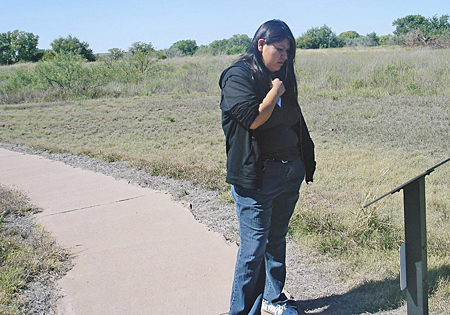
New Mexico Highlands University student Sherry Boone reads a memorial marker at Ft. Sumner during the university’s Native Identity learning community field trip to the site in October to learn more about the 1864 Long Walk of the Navajo.
Native Identity Learning Community Learns About Navajo Long Walk Through Trip to Ft. Sumner
Students from the New Mexico Highlands University Native Identity learning community went on a class field trip in October to Ft. Sumner, learning more about the 1864 Long Walk of the Navajo.
During the Long Walk, 8,000 Navajos were forced to walk 300 miles from Canyon de Chelly in Arizona to the Bosque Redondo area of New Mexico, where they were imprisoned.
The Highlands’ students returned to campus to write about the subsequent Navajo Treaty of 1868 in their English composition course, applying their new knowledge, cultural identity, and emotion to their writing.
“Learning communities provide students with the opportunity to explore a single topic from a variety of perspectives, which encourages more active learning and greater understanding,” said Barbara Risch, coordinator for the university’s Academic Enrichment Programs, and chair of the English and Philosophy Department. “One of the goals of the learning communities is to engage students in discovery in relevant and tangible ways. We want students to see how learning applies to their lives.”
Risch said learning communities aid retention because students become more engaged in learning, which helps make them want to stay and complete their education at Highlands University.
Three of the freshman enrolled in the Native Identity learning community are Lynnelle Logan, who is Navajo and San Carlos Apache, Andrew Shepard, a Navajo, and Stephany Begay, who is Navajo and Jicarilla Apache. All three participated in the Ft. Sumner field trip, the first time any of them had seen the site that is part of their heritage.
“When I was at Ft. Sumner I sensed the pain of my ancestors throughout time and started to cry,” Logan said. “It was a blessing that my great-great grandmother survived the Long Walk. The field trip helped me in my writing assignment, and I also interviewed my grandfather. He told me that language loss is hurtful to see, and know that it means you lose your identity.”
Shepard said: “When I went to Ft. Sumner I knew it wasn’t a good place for the Navajo people because 3,000 lives were lost there. I felt the anger and the hurt of what the people might have felt at that time. Going to Ft. Sumner gave me more details for my paper about Article 6 of the Navajo Treaty of 1868.”
One of Begay’s ancestors is Chief Manuelito, a principal chief of the Navajo people before, during and after the Long Walk.
“For me, being at Ft. Sumner was a whole realization of knowing my ancestors were here, and the torment they went through,” Begay said. “It helped my writing because I knew more about what happened there but honestly it was also painful.”
All three students said they would definitely recommend the Native Identity learning community to other students.
“You learn about the different types of Native American beliefs and hear their stories, and it’s interesting,” Begay said. “You also learn more about your own culture, and it helps your English education.”
Lujan said the learning community helps her express what she feels and her point of view.
Risch said the Native Identity Learning Community is just one example of how the university is working to incorporate topics that are significant to students. She said Teresa Billy of the university’s Native American Student Service Office suggested the Native Identity learning community earlier this year and was active in its development.
Visiting English professor Paul Zolbrod teaches the Native Identity class and English instructor Stephen Weatherburn teaches the English 100 course. They collaborate closely for the learning community.
“Together, Paul and Stephen have 50 years of experience working with Native American students, including teaching at the Navajo Nation’s Dine College,” Risch said. “Having them as instructors was absolutely vital.”
Zolbrod said that in his Native Identity class he tries to make his students more aware of their traditions, and enhance their ability to articulate their identity while they are at Highlands University.
“The class also validates their cultural heritage as something that’s important for them to study in an academic setting,” Zolbrod said.
Weatherburn said that his students felt a stronger sense of investment in their writing after the Ft. Sumner field trip because the subject was more tangible and powerful.
“The learning community allows students to connect knowledge and develop high level thinking skills,” Weatherburn said.”The students feel a sense of community because they are in both classes together, which gives them a comfortable classroom environment where it’s easier to express their opinions.”
During the fall semester, the university offered 12 learning communities across various disciplines and areas of interest. Other examples include geology, art and community, biology, music, astronomy, math and psychology. Risch said eight more learning communities are planned for spring semester 2010.
